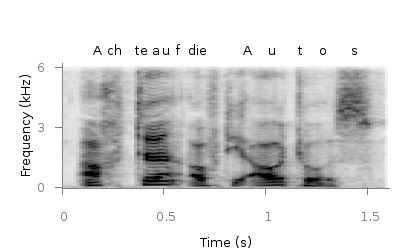November 29th, 2011 | 3 Comments
A spectrogram is a time-frequency representation that shows how the spectral content of a signal varies with time. In Fig. 1 the spectrogram of the German sentence “Achte auf die Autos” is shown.

Fig. 1 Spectrogram plotted with plot (code to produce this figure, data)
The spectrogram is plotted as mentioned in the color maps entry.
plot 'spec.dat' binary matrix with image
In addition the letters were putted on the graph at their corresponding time of occurrence. The letters itself and their positions are stored in the two lists syl and xpos. In order to access the single entries of these lists within a for loop the function word is needed.
# Adding the syllables syl = 'A ch te a u f d ie A u t \ o s ' xpos = '0.15 0.22 0.36 0.44 0.49 0.56 0.62 0.66 0.89 1.01 1.16 \ 1.26 1.42' set for [n=1:words(syl)] label word(syl,n) at word(xpos,n),6800
Another way to plot the spectrogram is by using splot which will result in a different kind of smoothing algorithm of the spectrogram, as can be seen in Fig. 2.

Fig. 2 Spectrogram plotted with splot (code to produce this figure, data)
But to get this result we have to fix some of the margins, because plot is two-dimensinal and splot is three-dimensional which is not desired here.
set border 10 front ls 11 set tmargin at screen 0.75 set bmargin at screen 0.25 set rmargin at screen 0.95 set lmargin at screen 0.15